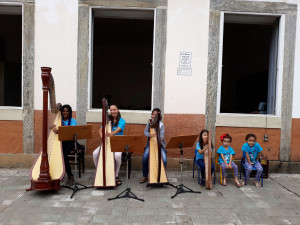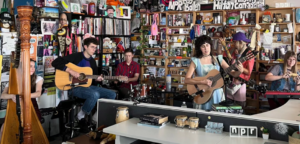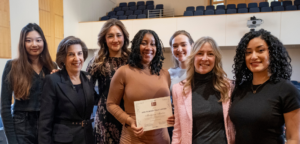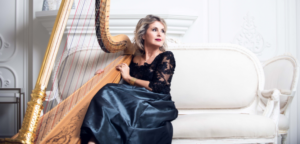Rayana do Val recently reached out to Harp Column to share news of an exciting new project: the creation of a harp library at Programa Integração pela Música (PIM) in Vassouras, Brazil, where she teaches. Intrigued by her work, we wanted to find out more about her career and the harp scene in Brazil.
Give us a snapshot of life as a harpist in based in São José dos Campos. What are some of the daily struggles? What excites you about being a harpist in Brazil?
I only recently got my bachelor degree in harp, and I came back to my hometown, São José dos Campos, in the state of São Paulo. I decided to keep my job at PIM in Vassouras (in the state of Rio), which is quite far from here. There were many reasons for this: first, of course, my love for the kids and the job, and second, because I really wanted to have a pedal harp that I could play now and then. Unfortunately, a pedal harp is extremely expensive in my country, and I don’t have one. At home I have my own lever harp, and I am developing my repertoire on it. I am still a bit of an alien in my city; all my professional connections are from Rio, and I am not in the music scene here. But little by little I have started to meet people.

Rayana do Val showing the harp to students in São José dos Campos
I’ve been doing some volunteer work here showing the harp to very young kids in schools. There was a very special moment when the 2–3 year old kids sat in front of the stage and started to clap and say, “START! START!” I was so touched—it was the most excited audience I had ever seen! Then, one of them waved at me and I waved back. All of a sudden, all 280 kids were waving and waiting for individual attention! I think I waved back at every single one of them. Later they came one by one to try the harp.
I think Brazil is so big, and there are so few harps and harpists here, so the most exciting thing is to know that there is space to grow and there are many possibilities. People are always delighted by the harp. You just have to insist and be creative.
How did you get introduced to the instrument? Where did you receive your training?
Well, to be honest, what moved me to play was listening to Loreena McKennitt when I was 19. We had no harp teachers here in SJC so I found a teacher in the city of São Paulo. I had lessons with Marcelo Penido for a few years, before moving to Rio de Janeiro, where I studied music education at Universidade Federal do Rio de Janeiro (UFRJ), taking harp lessons with Cristina Braga. Some years later I was accepted at the harp course and could finally graduate in May this year, eight years after starting university. It was quite a quest!
Both Penido and Braga studied with Susann McDonald, and I consider myself very lucky to have had such good teachers from the very beginning. One of my dreams was to study harp performance and pedagogy with Prof. McDonald in Indiana, but I guess I am just too late!
You teach at Programa Integração pela Música in Rio de Janeiro. What sets PIM apart from other music schools?
Most music schools in Brazil don’t have harp, even in the state capitals. PIM is a social program in a small town, and it has two lever harps and one pedal harp. The lessons are offered for free to kids from low–income families that study in the public system. Kids coming from private schools (meaning from families with more resources) are offered lessons for a small fee. To study at PIM, they have to show they are going to school and that they have good grades. They have to take part in the choir, take theory lessons, and play in the PIM’s orchestra from the very beginning. When they get more advanced, they take part in Opus, an ensemble of students and teachers playing gigs in the surrounding area. With this, they start making their own money with their music.

Students enrolled in harp lessons at Programa Integração pela Música
We have now 10 harp students and are growing. The intermediate or advanced students are monitors, offering help for beginners during the week. One of them, Aline Monsores, is now 13 and playing gigs. She won second prize in an online music competition when she was 10, competing with children from all instruments all over the world. A donor gave her a lap harp as a present some time ago! It is not PIM’s goal to form professional musicians, but to open to children new horizons through music, giving them new opportunities and showing them different alternatives for their lives. However, some former students studying other instruments have become musicians, playing in major orchestras in Brazil.
In my teaching, I talk about discipline and self–respect, and I encourage students to learn English. I am so grateful to speak English; this has opened countless opportunities for me, and I have certainly read so many more books and articles about music in English than in Portuguese.
When you think about the future of harp in Brazil, what do you hope for?
I hope there will be more incentives coming from the government for culture in general. Sadly, this is not the perspective now. Actually, when I left SJC to study in Rio, there was a professional city orchestra here. There were no harps, but harpists from other cities were hired when needed, and it was a good orchestra. Last year, the municipality closed it, firing all the musicians. It is very sad to see that culture is being less and less supported. Programs like PIM, if not supported by private initiatives, will end up having to close their doors.
Tell us about your project. You are creating a harp library at PIM. What exactly does that entail?
I want to create a real library, not only a collection of harp books. I have a name for it: Biblioteca Acácia Brazil de Mello. Prof. Acácia was a great Brazilian harpist and teacher; she was the teacher of my teacher Cristina Braga at UFRJ, and she also taught the teacher of my first teacher, Marcelo Penido. She passed away in 2008 but her legacy is here, and I am very grateful for her work.
The library will be located at PIM, which has a lot of space in a big building. I am still looking for information on how to catalogue, how to organize it easily. It is an old idea of mine, but only recently I decided to put it in practice. For the moment government funding is out of question, so I am asking for individual donations.
What resources are you hoping to provide? What is your end goal?
The intention is to make it a resource for all Brazilian harpists. It will be used to teach at PIM, but this is not the end goal. We don’t have a harp library in Brazil, not even in the few universities that offer a harp degree. We also don’t have music shops that sell harp music. During all my harp training, the only music I played was what was provided by the teacher. The first time I saw harp music for sale was during the Edinburgh International Harp Festival in 2013. I was so amazed by it; it looked like paradise for me!
Students and professional harpists will be welcome to come and visit the library, to try or listen to new music, search for methods, chamber music, orchestral parts. I think it is located in a very good place, close to the city of Rio, where UFRJ is, so university students can easily get there. It is also a way of turning Vassouras into a center for the harp in Brazil, which is our ultimate goal. The city recently received the donation of a new pedal harp, which will stay at the town’s main church, available for harpists use. It will also make it easier for PIM students to get gigs at the church and even teach privately.
For people who want to get involved, how can they help?
Anyone who has composed and arranged for the harp, or published a book, or recorded a CD or a DVD can help by sending us their material. Of course it doesn’t need to be their own music; they can send their favorite pieces or etudes for the harp. Retired harpists can also help by donating music they don’t use anymore; it doesn’t have to be new! I think shipping can be a problem if someone intends to send a lot of music. I encourage people to contact me if that is the case, so we can work together to find a solution.
We are not looking for one specific kind of music; it can be harp solos, harp ensemble, chamber music, orchestral, jazz, pop, Irish, etc. It can be methods for kids or adults, music for beginners or advanced harpists, books on history of the harp, manuals. Any type of harp-related material will be very much appreciated.
Anything else you’d like to add?
I am very grateful for being the head of this huge project, but it wouldn’t be possible without the cooperation of many people. PIM can only be what it is with the hard work of the coordinators, Célia and Cláudio Moreira, a lovely couple who founded and keep it, even in very difficult times. The supporters and volunteers are also indispensable.
The coordinators’ connections with Cristina Braga made it possible for Vassouras to now have five harps, all of them through cooperations with Camac Harps and/or donations. An anonymous maecenas from Rio has supported many projects.
PIM harp students have taken part in some very important harp events in Vassouras, like the Taller Itinerante de Arpas with Isabelle Moretti, Mercedes Gómez and Marisela González in 2014. The 2016 and 2018 Brazilian Jazz Harp Immersions, a collaboration of the Jazz Harp Foundation and Cristina Braga, put my students in contact with great musicians like Felice Pomeranz, Carol Robbins, Park Stickney, and Deborah Henson-Conant.
Canadian harpist Gianetta Baril has been coming as a volunteer to teach the kids every year since 2015. She was the one who taught me to teach harp to kids, and she always brings new music, strings, and all her knowledge to share with us. She donated one of the lever harps.
As a final word, I just want to thank all the people who spend money, time, and energy to share music and knowledge with us.













